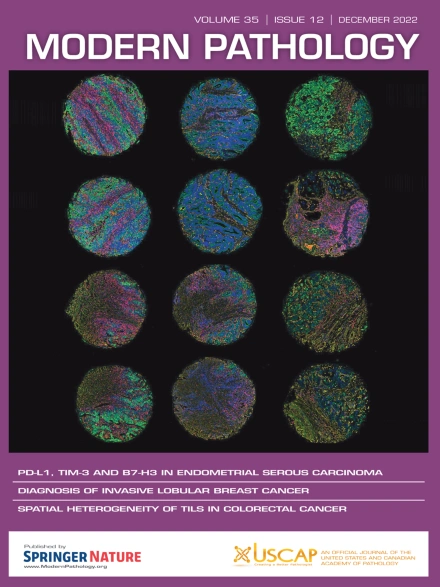Distinct Patterns of GLUT1 Expression in Human Papillomavirus Associated and Human Papillomavirus Independent Vulvar Intraepithelial Neoplasia and Squamous Cell Carcinoma
IF 7.1
1区 医学
Q1 PATHOLOGY
引用次数: 0
Abstract
The expression of GLUT1 in vulvar squamous cell carcinoma (SCC) and its precursors remains largely unknown. We systematically investigated GLUT1 expression in human papillomavirus (HPV)–associated and HPV-independent vulvar intraepithelial neoplasia (VIN) and SCC. Our study had a total of 240 cases, including 40 cases of non-neoplastic vulva, 45 HPV-associated high-grade squamous intraepithelial lesions (HSILs), 65 HPV-independent VINs, and 90 invasive SCCs. Immunohistochemical analysis revealed that GLUT1 was expressed noncontinuously at the basal layer near stromal papillae in most non-neoplastic vulvar squamous epithelium. Overexpression of GLUT1 was observed in 82.2% and 88.9% of HPV-associated HSIL and SCC, respectively, compared with 96.9% and 100% of HPV-independent VIN and SCC. Two distinct patterns of the GLUT1 expression were observed in HPV-associated and HPV-independent VIN and SCC. In HPV-associated HSIL, overexpression of GLUT1 was mainly noted in the upper intermediate layers, accompanied by negative or weak immunostaining in the basal and parabasal layers. Similar patterns were also found in HPV-associated SCC, characterized by increased GLUT1 staining intensity in the centers of tumor sheets or nests with spared basal peripheral layers. Conversely, intense membranous GLUT1 staining was mainly observed in the basal and suprabasal layers in HPV-independent VIN, regardless of p53 status. Similar intense basal and parabasal GLUT1 staining patterns and no or weak staining intensity in central areas were seen in HPV-independent SCCs. In conclusion, overexpression of GLUT1 was found in most vulvar SCCs and their precursors. We identified 2 distinct GLUT1 patterns between HPV-associated and HPV-independent VINs and SCCs. Given its high sensitivity, immunohistochemistry for GLUT1 can be a valuable tool for facilitating accurate diagnosis of VIN, especially the HPV-independent type.
GLUT1在hpv相关和不依赖hpv的外阴上皮内瘤变和鳞状细胞癌中的不同表达模式
GLUT1在外阴鳞状细胞癌及其前体中的表达在很大程度上仍然未知。我们系统地研究了GLUT1在hpv相关和不依赖hpv的外阴上皮内瘤变(VIN)和鳞状细胞癌(SCC)中的表达。我们的研究共纳入240例,其中非肿瘤性外阴40例,hpv相关HSIL 45例,hpv非依赖型VIN 65例,侵袭性鳞状细胞癌90例。免疫组化分析显示,在大多数非肿瘤性外阴鳞状上皮中,GLUT1在靠近间质乳头的基底层非连续表达。在hpv相关的HSIL和SCC中,GLUT1的过表达率分别为82.2%和88.9%,而在hpv无关的VIN和SCC中,GLUT1的过表达率分别为96.9%和100%。在hpv相关的和不依赖hpv的VIN和SCC中观察到两种不同的GLUT1表达模式。在hpv相关HSIL中,GLUT1的过表达主要出现在上中间层,并伴有基底和准基底层的免疫染色阴性或弱。在hpv相关的SCC中也发现了类似的模式,其特征是肿瘤片或巢中心的GLUT1染色强度增加,基底外周层保留。相反,无论p53状态如何,强烈的膜性GLUT1染色主要出现在hpv不依赖型VIN的基底和基底上层。在不依赖hpv的SCCs中,基底和基底旁的GLUT1染色模式相似,中心区域无或弱染色。总之,GLUT1在大多数外阴SCCs及其前体中均存在过表达。我们在hpv相关的和不依赖hpv的vin和SCCs中发现了两种不同的GLUT1模式。由于GLUT1的免疫组织化学检测具有较高的敏感性,因此可以作为一种有价值的工具,用于促进VIN的准确诊断,特别是hpv非依赖型。
本文章由计算机程序翻译,如有差异,请以英文原文为准。
求助全文
约1分钟内获得全文
求助全文
来源期刊

Modern Pathology
医学-病理学
CiteScore
14.30
自引率
2.70%
发文量
174
审稿时长
18 days
期刊介绍:
Modern Pathology, an international journal under the ownership of The United States & Canadian Academy of Pathology (USCAP), serves as an authoritative platform for publishing top-tier clinical and translational research studies in pathology.
Original manuscripts are the primary focus of Modern Pathology, complemented by impactful editorials, reviews, and practice guidelines covering all facets of precision diagnostics in human pathology. The journal's scope includes advancements in molecular diagnostics and genomic classifications of diseases, breakthroughs in immune-oncology, computational science, applied bioinformatics, and digital pathology.
 求助内容:
求助内容: 应助结果提醒方式:
应助结果提醒方式:


